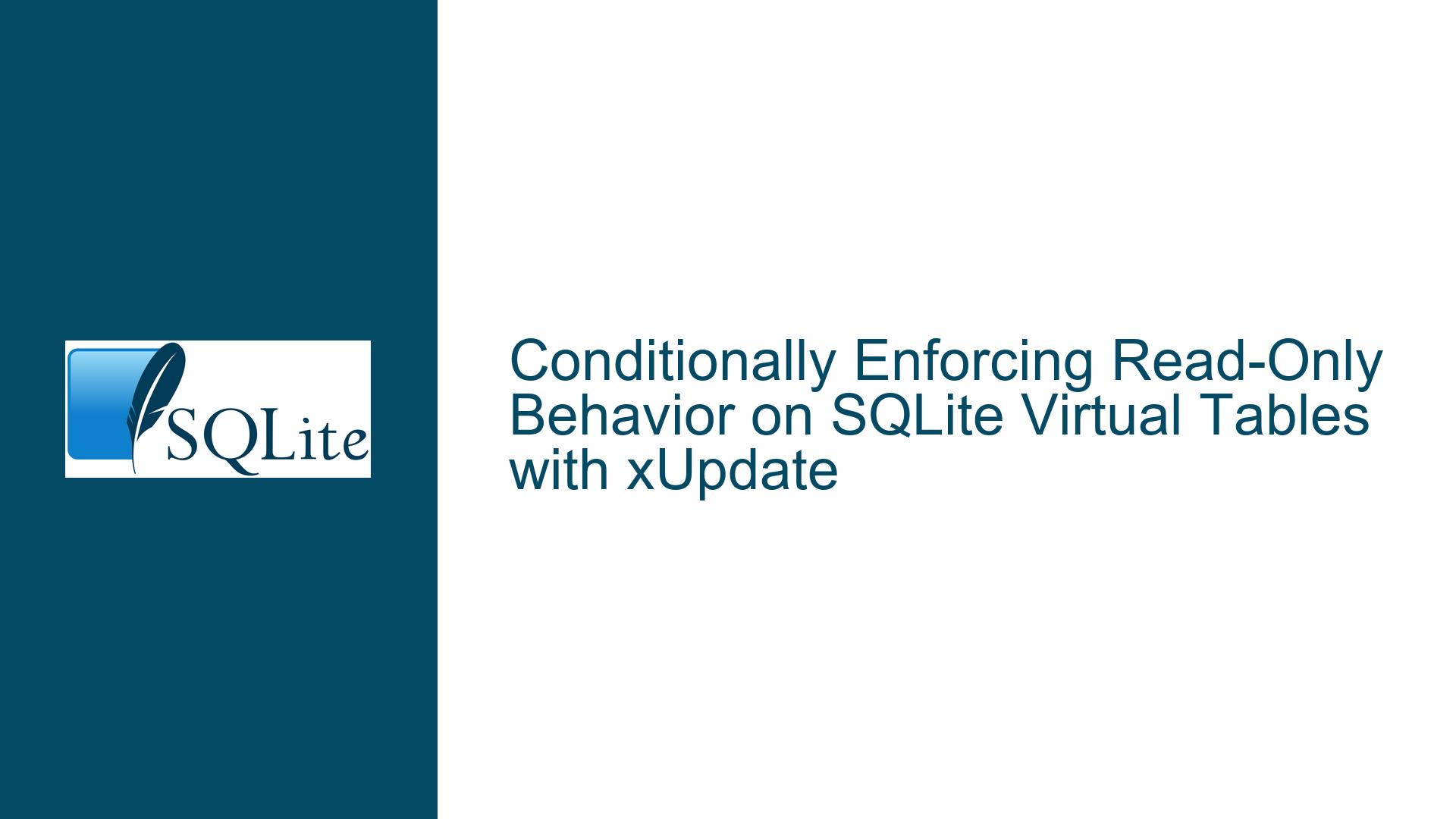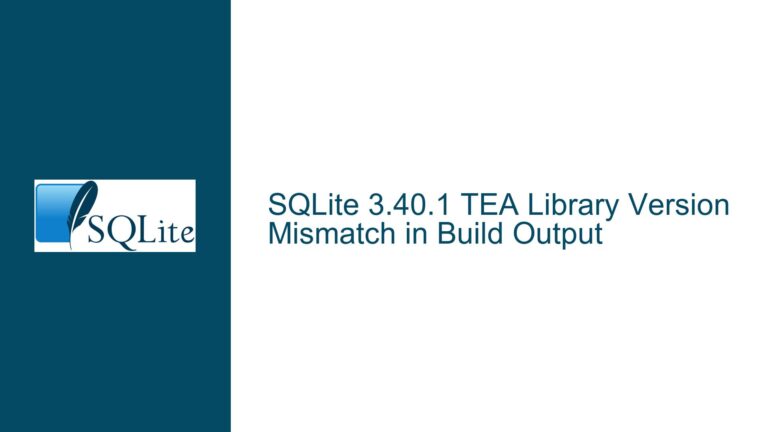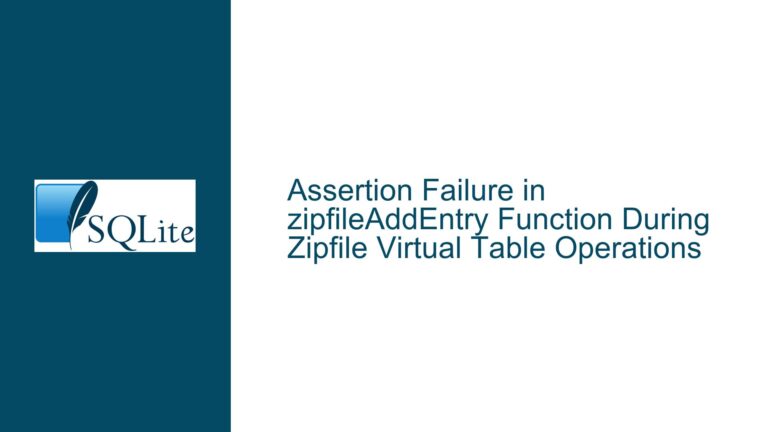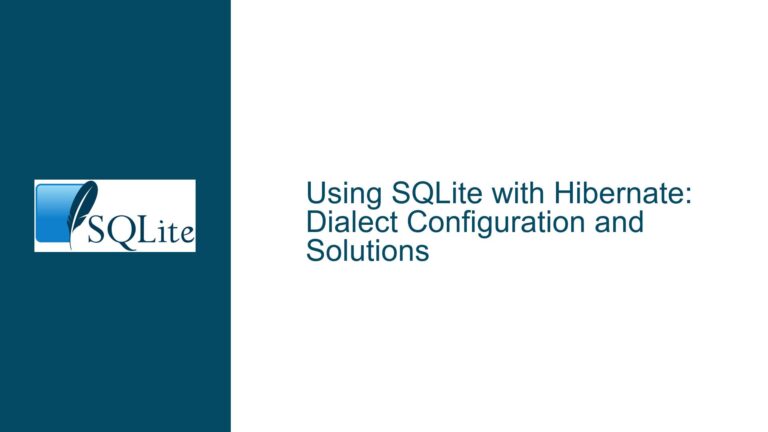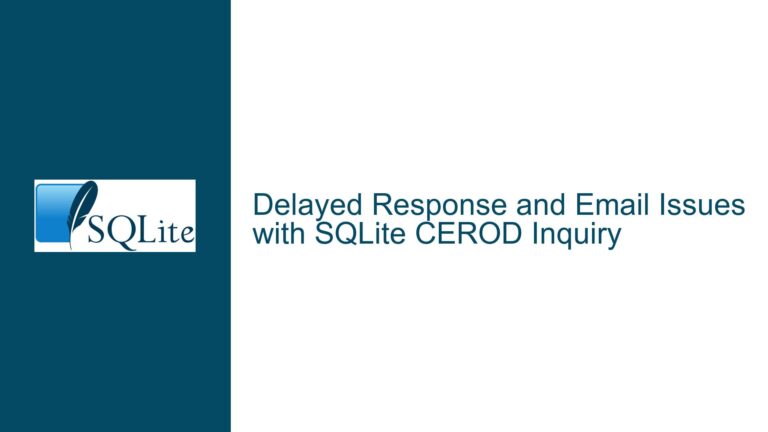Conditionally Enforcing Read-Only Behavior on SQLite Virtual Tables with xUpdate
Virtual Table Read-Only Enforcement Dynamics and xUpdate Error Handling Strategies
Understanding Virtual Table Mutability Control in SQLite
The challenge revolves around configuring SQLite virtual tables to exhibit read-only behavior under specific runtime conditions while retaining an active xUpdate method. Developers often implement virtual tables to interface with external data sources or custom data structures. A common requirement is to conditionally restrict write operations based on parameters passed during virtual table creation (via xCreate/xConnect). SQLite does not natively provide a direct mechanism to dynamically toggle the read-only status of a virtual table when xUpdate is defined. This creates a conflict: the presence of xUpdate signals to SQLite that the table supports mutations, but specific instances of the table may need to reject such operations programmatically.
The crux lies in SQLite’s error reporting pipeline. When a virtual table lacks an xUpdate method, the SQLite parser identifies mutation attempts (INSERT/UPDATE/DELETE) during the sqlite3_prepare() phase and raises an immediate error. However, if xUpdate exists, SQLite defers mutability checks to execution time (sqlite3_step()). This deferred error reporting complicates scenarios where developers want certain virtual table instances to behave as read-only while others remain writable, all using the same module.
Root Causes of Unintended Writable Behavior in Virtual Tables
Three primary factors contribute to this issue:
1. xUpdate Method Presence Overrides Innate Read-Only Detection
SQLite determines a virtual table’s mutability by checking for the existence of xUpdate during schema validation. If the method is present, the engine assumes the table is writable. This design bypasses any runtime logic developers might implement within xUpdate to conditionally block mutations. The parser cannot introspect the implementation of xUpdate; it merely verifies its existence.
2. Late-Phase Error Reporting in Prepared Statements
When xUpdate is defined but intentionally blocks mutations, errors arise during statement execution (sqlite3_step()) rather than preparation (sqlite3_prepare()). This complicates client applications expecting immediate feedback during the prepare phase. For example, a GUI application might disable "Save" buttons upfront if a table is read-only, but with deferred errors, this status isn’t known until execution.
3. Module Parameterization Limitations
Virtual tables accept module-specific arguments during creation (e.g., CREATE VIRTUAL TABLE t USING mod(args);). While developers can parse these arguments in xCreate/xConnect to determine whether a table instance should be read-only, SQLite provides no built-in mechanism to propagate this decision to the core engine. The engine’s mutability checks remain unaware of these parameters, forcing developers to handle read-only logic entirely within xUpdate.
Implementing Conditional Read-Only Enforcement via xUpdate
To enforce read-only behavior on specific virtual table instances while retaining xUpdate, developers must implement a runtime check within the xUpdate method itself. This approach ensures SQLite’s parser still recognizes the table as technically writable (allowing DML statements to prepare successfully), while mutations are blocked during execution based on custom logic.
Step 1: Define a Table-Specific Read-Only Flag
Within the virtual table’s sqlite3_vtab structure, add a boolean flag indicating whether the instance is read-only. This flag is set during xCreate/xConnect based on module arguments or other runtime conditions.
typedef struct CustomVtab {
sqlite3_vtab base;
int is_read_only;
} CustomVtab;
In xCreate, parse the module arguments to determine if the table should be read-only:
int xCreate(sqlite3 *db, void *pAux, int argc, const char *const*argv,
sqlite3_vtab **ppVtab, char **pzErr) {
CustomVtab *pNew = sqlite3_malloc(sizeof(CustomVtab));
// ... initialize base structure ...
pNew->is_read_only = 0;
for (int i = 0; i < argc; i++) {
if (strcmp(argv[i], "read_only") == 0) {
pNew->is_read_only = 1;
break;
}
}
*ppVtab = (sqlite3_vtab*)pNew;
return SQLITE_OK;
}
Step 2: Implement Conditional Error Raising in xUpdate
Modify the xUpdate method to check the is_read_only flag and return an error if mutations are disallowed:
int xUpdate(sqlite3_vtab *pVtab, int argc, sqlite3_value **argv,
sqlite3_int64 *pRowid) {
CustomVtab *p = (CustomVtab*)pVtab;
if (p->is_read_only) {
sqlite3_log(SQLITE_READONLY, "Table is read-only");
return SQLITE_READONLY; // Or a custom error code
}
// ... proceed with normal write logic ...
}
Step 3: Handle SQLITE_READONLY in Application Code
Client applications must handle SQLITE_READONLY errors during sqlite3_step(). To mimic the behavior of a table without xUpdate, applications can preemptively check mutability by querying a virtual table’s schema (e.g., via PRAGMA table_info or custom functions). Alternatively, expose the read-only status through an auxiliary function:
int is_table_read_only(sqlite3 *db, const char *tblName) {
// Query table's schema or internal registry
}
Advanced: Custom Error Codes for Granular Diagnostics
Instead of SQLITE_READONLY, use application-defined error codes (SQLITE_ERROR + extended error messages) to distinguish between read-only errors and other failures. This aids debugging:
if (p->is_read_only) {
sqlite3_result_error_code(pCtx, SQLITE_READONLY);
sqlite3_result_substr(pCtx, "Virtual table is configured as read-only", -1);
return SQLITE_ERROR;
}
Performance and Usability Considerations
- Overhead: The runtime check in
xUpdateadds negligible overhead unless the method is called excessively. - Error Consistency: Applications must be redesigned to handle late-phase errors, which may require transaction rollbacks or user notifications.
- Schema Reflection: Tools or ORMs that introspect table schemas via
PRAGMAstatements will still see the table as writable. Mitigate this by implementing anxBestIndexcallback that rejects mutation-related queries at prepare time when possible.
Alternative Approach: Dynamic xUpdate Method Registration
For scenarios where read-only status is known at module initialization, conditionally set the xUpdate pointer in sqlite3_module to NULL during xCreate. This requires maintaining multiple sqlite3_module structures:
static sqlite3_module writable_module = {
.xCreate = xCreate,
.xUpdate = xUpdate,
// ... other methods ...
};
static sqlite3_module readonly_module = {
.xCreate = xCreate,
.xUpdate = NULL, // No xUpdate method
// ... other methods ...
};
During virtual table creation, register the appropriate module based on parameters. This approach restores early error reporting (sqlite3_prepare() failures) for read-only instances but complicates module management.
Conclusion
Conditional read-only enforcement in SQLite virtual tables requires deliberate error handling within the xUpdate method, coupled with runtime flag checks. While this defers error reporting to the execution phase, it provides flexibility in mutability control. Developers must weigh this against the need for immediate error detection, potentially employing hybrid approaches with dynamic module registration. Proper documentation of the virtual table’s behavior is critical for API consumers to handle read-only errors appropriately.
